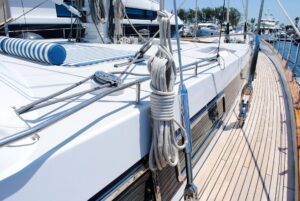What are Wood Plastic Composites?

Wood-plastic composites (WPCs) are composite materials made of wood fiber/wood flour and thermoplastic(s) such as polythene (PE), polypropylene (PP), polyvinyl chloride (PVC), or polylactic acid (PLA).
In addition to wood fiber and plastic, WPCs can also contain other ligno-cellulosic and/or inorganic filler materials. WPCs are a subset of a larger category of materials called natural fiber plastic composites (NFPCs), which may contain no cellulose-based fiber fillers such as pulp fibers, peanut hulls, coffee husk, bamboo, straw, digestate, rice husk, recycled papers.
Chemical additives seem practically “invisible” (except mineral fillers and pigments, if added) in the composite structure. They provide for integration of polymer and wood flour (powder) while facilitating optimal processing conditions.
WPCs are still new materials relative to the long history of natural lumber as a building material. The most widespread use of WPCs in North America is in outdoor deck floors, but it is also used for railings, fences, landscaping timbers, cladding and siding, park benches, molding & trim, window and door frames, and indoor furniture. WPCs were first introduced into the decking market in the early 1990s. Manufacturers claim that WPC is more environmentally friendly and requires less maintenance than the alternatives of solid wood treated with preservatives or solid wood of rot-resistant species. These materials can be molded with or without simulated wood grain details.
WPCs are produced by thoroughly mixing ground wood particles and heated thermoplastic resin. The most common method of production is to extrude the material into the desired shape, though injection molding is also used. WPCs may be produced from either virgin or recycled thermoplastics including high-density polyethylene (HDPE), low-density polyethylene (LDPE), polyvinyl chloride (PVC), polypropylene (PP), acrylonitrile butadiene styrene (ABS), polystyrene (PS), and polylactic acid (PLA). PE-based WPCs are by far the most common. Additives such as colorants, coupling agents, UV stabilizers, blowing agents, foaming agents, and lubricants help tailor the end product to the target area of application. Extruded WPCs are formed into both solid and hollow profiles. A large variety of injection molded parts are also produced, from automotive door panels to cell phone covers.
In some manufacturing facilities, the constituents are combined and processed in a pelletizing extruder, which produces pellets of the new material. The pellets are then re-melted and formed into the final shape. Other manufacturers complete the finished part in a single step of mixing and extrusion
WPCs do not corrode and are highly resistant to rot, decay, and marine borer attack, though they do absorb water into the wood fibers embedded within the material. Water absorption is more pronounced in WFCs with a hydrophilic matrix such as PLA and also leads to decreased mechanical stiffness and strength. The mechanical performance in a wet environment can be enhanced by an acetylation treatment. WPCs have good workability and can be shaped using conventional woodworking tools. WPCs are often considered a sustainable material because they can be made using recycled plastics and the waste products of the wood industry. Although these materials continue the lifespan of used and discarded materials, They can however be recycled easily in a new WPC, much like concrete. One advantage over wood is the ability of the material to be molded to meet almost any desired shape. A WPC member can be bent and fixed to form strong arching curves. Another major selling point of these materials is their lack of need for paint. They are manufactured in a variety of colors, but are widely available in grays and earth tones. Despite up to 70 percent cellulose content (although 50/50 is more common), the mechanical behavior of WPCs is most similar to neat polymers. Neat polymers are polymerized without added solvents. This means that WPCs have a lower strength and stiffness than wood, and they experience time and temperature-dependent behavior.
Above contents sourced from Wikipedia



